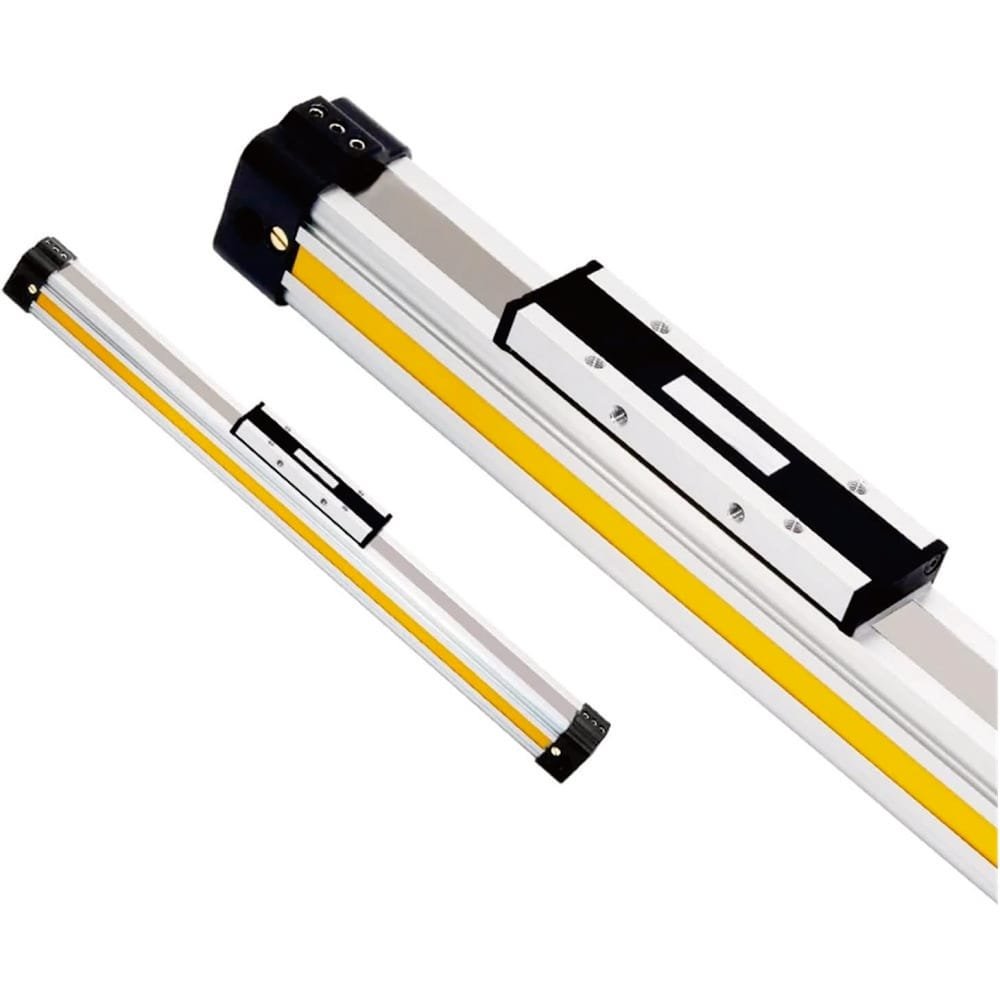Contamination destroys rodless cylinders faster than any other factor, causing premature seal failure and costly downtime. Without proper dust protection, even high-quality cylinders fail within months in dirty environments. This reality costs manufacturers thousands in replacement parts and lost production time. Rodless cylinder dust bands function as engineered sealing barriers that prevent contaminants from entering the cylinder bore through precise lip design, material selection, and pressure differential management, extending cylinder life by up to 300% in harsh environments.
Just last week, I spoke with David, a maintenance engineer at a cement plant in Phoenix, whose rodless cylinders were failing every 3-4 months due to dust infiltration until we implemented our advanced dust band solution.
Table of Contents
- What Are the Critical Design Elements of Rodless Cylinder Dust Bands?
- How Do Different Dust Band Materials Affect Performance in Industrial Applications?
- Which Installation Techniques Maximize Dust Band Effectiveness?
- What Are the Common Failure Modes and Prevention Strategies for Dust Bands?
What Are the Critical Design Elements of Rodless Cylinder Dust Bands? 🔧
Understanding the fundamental engineering principles behind dust band design is essential for selecting the right protection system for your rodless cylinder applications.
Critical dust band design elements include lip geometry for optimal sealing contact, material durometer1 for flexibility and wear resistance, mounting groove dimensions for secure retention, and pressure relief features to prevent seal damage during operation.

Lip Geometry and Contact Pressure
The sealing lip represents the most critical component of dust band performance:
Lip Design Parameters
- Contact angle: Typically 15-25 degrees for optimal sealing
- Lip thickness: 0.5-1.5mm for balance between flexibility and durability
- Contact width: 0.2-0.8mm for effective contamination barrier
- Relief angle: 5-10 degrees to prevent excessive drag force
Groove Design Specifications
Proper mounting groove design ensures reliable dust band retention:
| Design Element | Standard Range | Critical Function | Tolerance Requirements |
|---|---|---|---|
| Groove Width | 3.0-8.0mm | Secure mounting | ±0.1mm |
| Groove Depth | 1.5-4.0mm | Compression control | ±0.05mm |
| Corner Radius | 0.2-0.5mm | Stress distribution | ±0.02mm |
| Surface Finish | Ra 0.8-1.6μm2 | Sealing integrity | Critical |
Pressure Management Features
Advanced dust bands incorporate pressure relief mechanisms:
Relief Valve Integration
- Bypass channels prevent pressure buildup behind the seal
- Venting grooves allow controlled air escape during operation
- Pressure equalization maintains optimal sealing force
- Dynamic adjustment adapts to varying operating conditions
Material Property Requirements
Dust band materials must balance multiple performance characteristics:
Key Material Properties
- Shore A hardness: 70-90 for most applications
- Tensile strength: Minimum 10 MPa for durability
- Elongation: 200-400% for installation flexibility
- Temperature range: -40°C to +150°C for versatility
- Chemical resistance: Compatible with hydraulic fluids and cleaners
Our Bepto rodless cylinders feature proprietary dust band designs optimized for maximum contamination protection while minimizing friction and wear. 💪
How Do Different Dust Band Materials Affect Performance in Industrial Applications? 🏭
Material selection significantly impacts dust band performance, durability, and compatibility with specific operating environments and contamination types.
Polyurethane3 offers superior abrasion resistance for heavy contamination, while nitrile provides excellent chemical compatibility, and PTFE delivers ultra-low friction for high-speed applications, each requiring specific hardness and compound formulations for optimal performance.

Polyurethane Dust Bands
Polyurethane represents the most versatile material choice for demanding applications:
Performance Characteristics
- Abrasion resistance: 10x better than rubber compounds
- Load capacity: Handles high contact pressures effectively
- Temperature stability: Maintains properties from -30°C to +80°C
- Chemical compatibility: Resistant to oils, greases, and most solvents
Material Comparison Analysis
| Material Type | Abrasion Resistance | Chemical Resistance | Temperature Range | Cost Factor |
|---|---|---|---|---|
| Polyurethane | Excellent | Good | -30°C to +80°C | 1.0x |
| Nitrile (NBR) | Good | Excellent | -20°C to +100°C | 0.7x |
| PTFE | Fair | Excellent | -50°C to +200°C | 2.5x |
| Silicone | Poor | Good | -60°C to +200°C | 1.8x |
Application-Specific Material Selection
Different industries require tailored material solutions:
Industry Requirements
- Food processing: FDA-approved compounds with bacterial resistance
- Chemical plants: Aggressive chemical compatibility and high temperature resistance
- Mining operations: Maximum abrasion resistance and particle rejection
- Clean rooms: Low outgassing materials with minimal particle generation
Compound Formulation Impact
Advanced material compounds enhance specific performance aspects:
Additive Technologies
- Carbon black increases abrasion resistance by 40%
- Silica fillers improve tear strength and flexibility
- Antioxidants extend service life in high-temperature applications
- Colorants provide visual wear indicators for maintenance scheduling
David’s cement plant application required our specialized high-durometer polyurethane dust bands with embedded wear indicators. After switching from standard rubber seals, his cylinder life increased from 4 months to over 18 months, saving $15,000 annually in replacement costs. ✨
Which Installation Techniques Maximize Dust Band Effectiveness? ⚙️
Proper installation procedures are crucial for achieving optimal dust band performance and preventing premature failure in rodless cylinder applications.
Effective dust band installation requires precise groove preparation, controlled compression during assembly, proper lubrication techniques, and systematic pressure testing to ensure reliable sealing performance and maximum service life.
Pre-Installation Preparation
Thorough preparation prevents installation damage and ensures optimal performance:
Surface Preparation Steps
- Groove cleaning: Remove all debris, oils, and old seal residue
- Dimension verification: Confirm groove specifications match design requirements
- Surface inspection: Check for scratches, burrs, or geometric irregularities
- Lubrication application: Apply compatible assembly lubricant sparingly
Installation Tool Requirements
Specialized tools prevent damage during dust band installation:
| Tool Type | Function | Critical Features | Quality Impact |
|---|---|---|---|
| Seal Pullers | Safe removal | Non-marring tips | Prevents groove damage |
| Installation Cones | Guided insertion | Smooth transitions | Eliminates lip damage |
| Compression Gauges | Force measurement | Accurate readings | Optimal sealing pressure |
| Inspection Mirrors | Visual verification | Clear visibility | Complete installation check |
Step-by-Step Installation Process
Systematic installation procedures ensure consistent results:
Installation Sequence
- Initial inspection: Verify dust band condition and dimensions
- Groove preparation: Clean and inspect mounting surfaces thoroughly
- Lubrication application: Apply thin, even coating to seal and groove
- Controlled insertion: Use installation tools to prevent lip damage
- Compression verification: Confirm proper seating and contact pressure
- Final inspection: Check for twisted lips or installation defects
Quality Control Measures
Post-installation verification prevents field failures:
Verification Procedures
- Pressure testing: Confirm sealing integrity under operating pressure
- Visual inspection: Check lip contact and groove engagement
- Movement testing: Verify smooth operation without binding
- Leak detection: Use appropriate methods to identify potential issues
Common Installation Errors
Avoiding typical mistakes improves installation success rates:
Error Prevention
- Over-compression causes premature wear and excessive friction
- Under-lubrication leads to installation damage and poor sealing
- Contamination during installation compromises sealing performance
- Improper tools result in lip damage and reduced service life
Sarah, a production manager at a packaging facility in Manchester, implemented our installation training program for her maintenance team. Following proper procedures reduced their dust band failure rate by 75% and extended average service intervals from 6 to 24 months. 🎯
What Are the Common Failure Modes and Prevention Strategies for Dust Bands? 🛠️
Understanding typical dust band failure mechanisms enables proactive maintenance strategies and design improvements for extended service life in rodless cylinder applications.
Common dust band failures include lip wear from abrasive contamination, chemical degradation from incompatible fluids, thermal damage from excessive temperatures, and installation damage from improper procedures, each requiring specific prevention strategies and material selections.
Primary Failure Mechanisms
Systematic analysis reveals the most common dust band failure modes:
Wear-Related Failures
- Abrasive wear4: Particle contamination gradually erodes sealing lips
- Adhesive wear: Metal-to-seal contact causes material transfer
- Fatigue wear: Repeated flexing creates crack initiation points
- Corrosive wear: Chemical attack weakens material structure
Failure Mode Analysis
| Failure Type | Typical Causes | Visual Indicators | Prevention Strategy |
|---|---|---|---|
| Lip Wear | Abrasive particles | Rounded edges, reduced height | Better filtration, harder materials |
| Chemical Attack | Incompatible fluids | Swelling, cracking, discoloration | Material compatibility testing |
| Thermal Damage | Excessive heat | Hardening, brittleness | Temperature monitoring, cooling |
| Installation Damage | Improper tools | Cuts, nicks, twisted lips | Training, proper tooling |
Predictive Maintenance Strategies
Proactive monitoring prevents unexpected failures:
Monitoring Techniques
- Visual inspection: Regular examination for wear indicators
- Performance trending: Track sealing effectiveness over time
- Contamination analysis: Monitor particle levels and types
- Temperature monitoring: Detect thermal stress conditions
Design Improvements for Failure Prevention
Advanced dust band designs address common failure modes:
Enhanced Design Features
- Wear indicators: Visual cues for replacement timing
- Improved materials: Enhanced resistance to specific contaminants
- Optimized geometry: Reduced stress concentrations and wear patterns
- Protective coatings: Additional barrier layers for harsh environments
Maintenance Best Practices
Systematic maintenance extends dust band service life:
Maintenance Schedule
- Weekly: Visual inspection and contamination assessment
- Monthly: Performance verification and wear measurement
- Quarterly: Detailed inspection and replacement planning
- Annually: Complete system review and upgrade evaluation
Cost-Benefit Analysis of Prevention
Proactive dust band maintenance delivers significant economic benefits:
Economic Impact
- Reduced downtime: Prevents unexpected cylinder failures
- Lower replacement costs: Extends component service life
- Improved reliability: Maintains consistent production output
- Enhanced safety: Prevents contamination-related hazards
Our Bepto dust band systems incorporate advanced wear-resistant materials and predictive maintenance features that help customers achieve 2-3x longer service life compared to standard solutions. 🚀
Conclusion
Proper dust band engineering combines optimal design geometry, appropriate material selection, correct installation procedures, and proactive maintenance strategies to maximize rodless cylinder protection and service life.
FAQs About Rodless Cylinder Dust Bands
Q: How often should rodless cylinder dust bands be replaced in typical industrial applications?
Dust band replacement intervals typically range from 6-24 months depending on contamination levels, operating conditions, and material selection. Regular inspection every 3 months helps determine optimal replacement timing based on actual wear patterns and performance degradation.
Q: Can dust bands be retrofitted to existing rodless cylinders that don’t have them?
Most rodless cylinders can be retrofitted with dust bands through groove machining or external mounting systems. However, internal modifications may require cylinder disassembly and should be performed by qualified technicians to maintain sealing integrity and performance.
Q: What’s the difference between dust bands and wipers in rodless cylinder applications?
Dust bands provide static sealing protection when the cylinder is stationary, while wipers actively clean the moving components during operation. Many applications benefit from both systems working together to provide comprehensive contamination protection throughout the operating cycle.
Q: How do environmental conditions affect dust band material selection?
Temperature extremes, chemical exposure, UV radiation, and contamination types all influence material choice. Polyurethane works well in most conditions, while specialized compounds like PTFE or silicone may be required for extreme temperatures or aggressive chemical environments.
Q: What are the signs that indicate dust band replacement is needed?
Key indicators include visible lip wear, reduced sealing effectiveness, increased contamination in the cylinder, unusual operating noise, and performance degradation. Regular inspection helps identify these signs before they lead to cylinder failure or costly downtime.
-
Learn about the durometer hardness scale and how it’s used to measure material properties. ↩
-
Understand the definition of Ra (Roughness average) and its importance for material sealing. ↩
-
Explore the material properties of polyurethane, especially its high abrasion resistance. ↩
-
Get a technical definition of abrasive wear and how it causes material degradation. ↩



